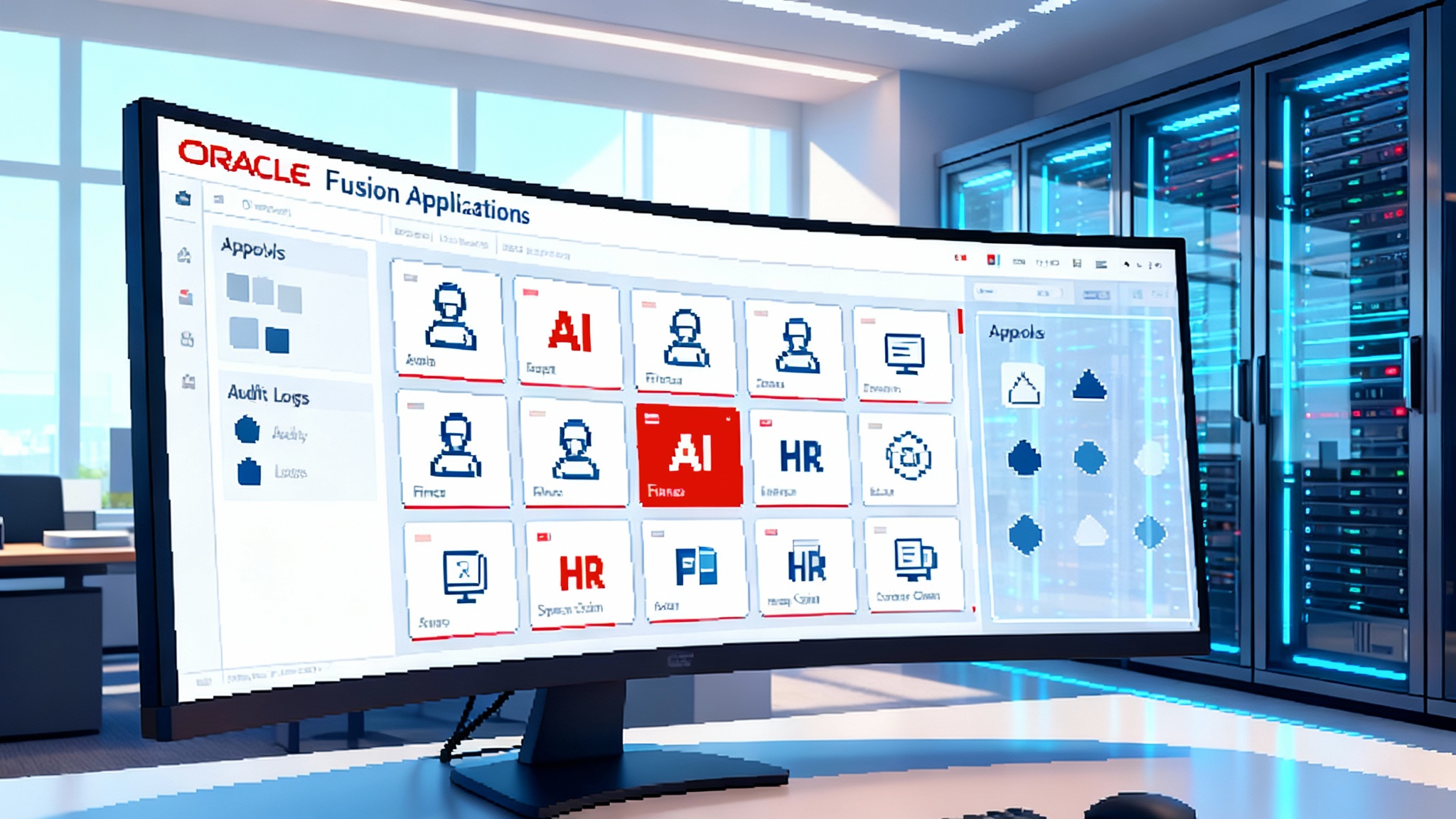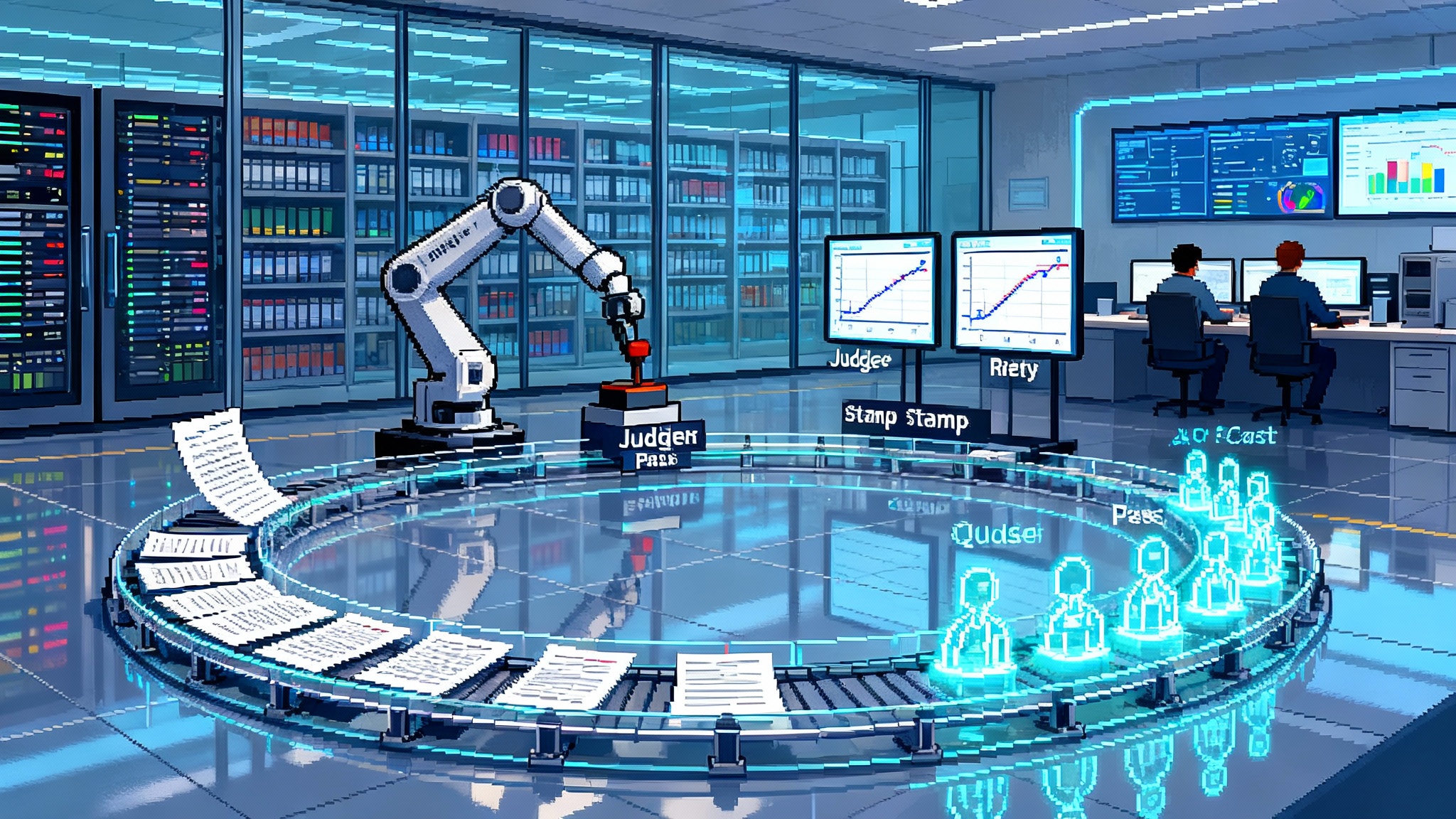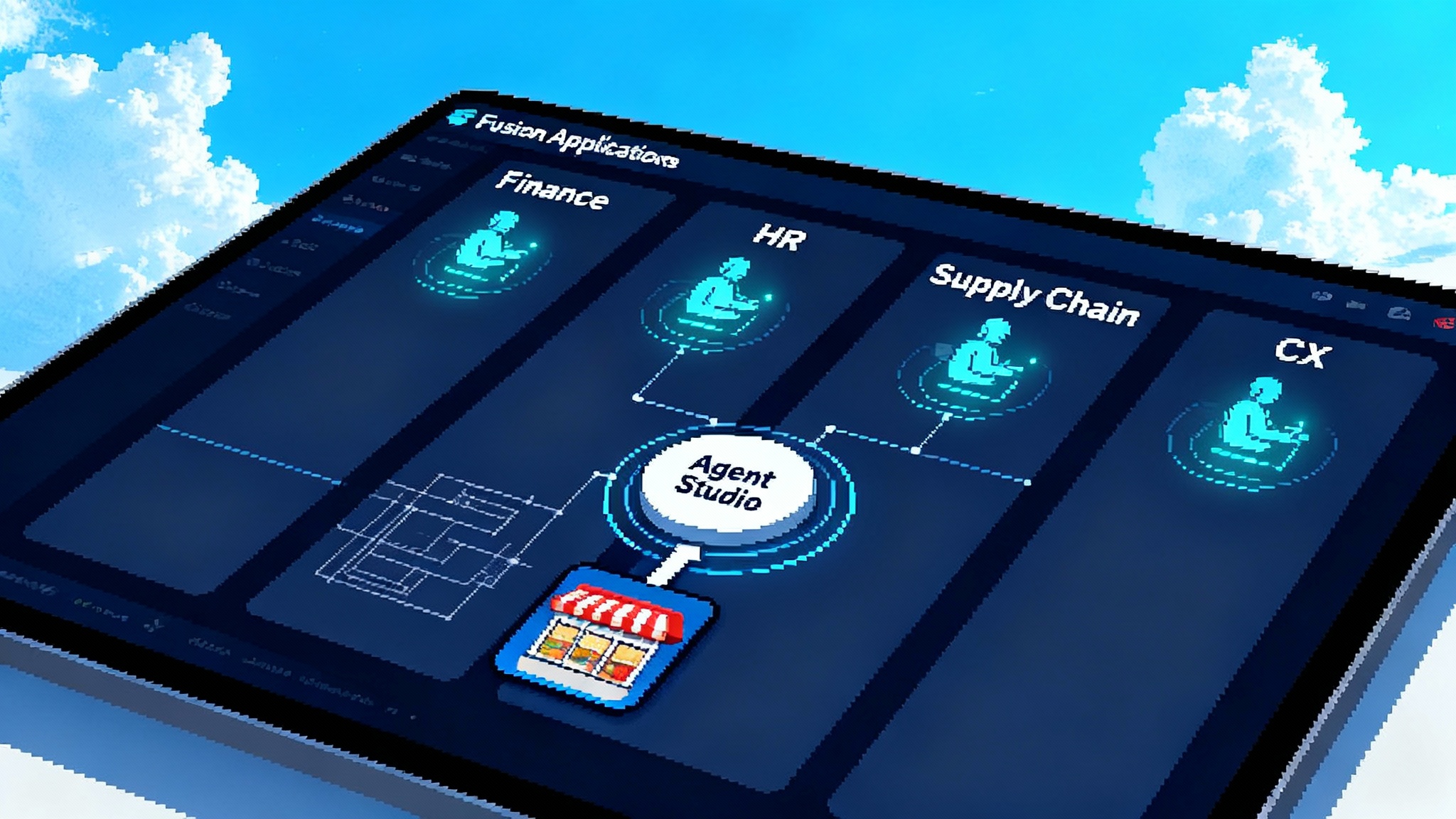Oracle’s Agent Marketplace Lands Inside Fusion Applications
Oracle is taking enterprise agents mainstream by placing a curated marketplace and an expanded AI Agent Studio inside Fusion Applications. With IBM shipping early agents, ERP becomes the safest path for multi model automation.

The news: agents move from pilot to production
On October 15, 2025, Oracle put a clear stake in the ground for enterprise agents by announcing an in application marketplace and expanded support in AI Agent Studio inside Oracle Fusion Applications. The marketplace curates partner built agents and lets customers deploy them straight into finance, human resources, and supply chain workflows. Oracle positioned this as a path to scale adoption, not as another lab demo, with native placement inside Fusion, a validation program for partners, and support for multiple large language models. You can see the details in Oracle's press release under the section on the marketplace and studio updates, published as Oracle expands AI Agent Studio.
One day later, IBM said it had three agents available on Oracle’s marketplace, focused on intercompany agreements, smart sales order entry, and converting requisitions to contract purchase orders. That move signaled something important. Agents are no longer proofs of concept built by innovation teams off to the side. They are graduating into production work that is measurable in hours saved, errors avoided, and cycle time reduced. IBM summarized the scope and intent of its first releases in a short update, detailed as IBM outlines three Fusion agents.
Why ERP is a natural home for agents
Enterprise resource planning brings together finance, procurement, human resources, and supply chain in a single system of record. That system has decades of investment in security, entitlements, and controls. It already knows which user can approve a purchase order, which segregation of duties rule blocks a finance clerk from both creating and approving a payment, and which supplier fields are confidential.
Agents live or die on context and policy. Place an agent inside ERP and it receives the correct context and the guardrails it needs. Think of an agent as a junior analyst that can read, propose, and act, but only within policy. Inside Fusion, the agent does not need to guess which supplier master to touch or what a spending limit is. The application already encodes it. The result is less glue code, fewer blind spots, and a shorter path to safe autonomy.
This design mirrors patterns we have seen in other control planes for agents. In CRM, for instance, a consolidated control layer can shape where and how agents act, a theme we explored when we looked at CRM as agent control plane. Similar consolidation is happening on the infrastructure side as clouds formalize agent primitives, as covered in our review of the AWS Bedrock AgentCore shift.
What changed in 2025
Three shifts converged this year to make agents viable at scale:
-
The marketplace route, not the app store route. Oracle embedded the marketplace where work already happens. The agent tiles sit next to existing tasks. That placement reduces the distance between discovery and use, which is the single best predictor of adoption inside large enterprises.
-
A multi model stance from day one. Oracle AI Agent Studio supports models from multiple providers. That creates a right tool for the job posture. A finance variance explanation agent might prefer a model strong in reasoning. A supplier email summarization agent might prefer a model tuned for long context. The studio provides one place to configure and govern those choices while keeping data inside familiar boundaries.
-
Partners are building the last mile. IBM’s initial agents target real pains: intercompany reconciliation, order capture, and converting a requisition into a contract purchase order. These are tasks that steal time from experienced staff and carry compliance risk when done poorly. Partner built agents translate general capabilities into domain specific shortcuts.
How it plays out inside finance
Imagine the quarter end intercompany reconciliation. Today, a team combs through agreements, checks transfer prices, matches invoices and journals, and writes up exceptions. An intercompany agent can read the agreements, inspect the journals, ask for missing documents, and propose entries. It does not post them outright. It assembles a draft with supporting evidence, highlights deltas against policy, and routes to the appropriate role for approval, all within existing Fusion workflows.
The measurable outcomes are practical. You see fewer late night hours during close, a shorter exception list, and a cleaner audit trail. The agent generates explanations a controller can file. If it runs into an oddity, it does not invent a fix. It requests a human decision and records the conversation alongside the journal. That is the kind of accountability auditors look for.
A supply chain example with policy in the loop
Take a requisition to contract process. Buyers often copy details into a contract purchase order, confirm terms, and reconcile catalog items. An agent can extract supplier terms from prior agreements, draft the contract, flag deviations, and pre fill catalog references. The buyer still decides. Cycle time drops from days to hours without bypassing controls. Because the agent works inside the same procurement module, it respects price lists, payment terms, and approval chains.
Why this moment is different
For years, enterprise teams experimented with agents in sandboxes. The friction came from missing context, weak entitlements, and brittle integrations. Oracle’s move situates agents where identity, policy, and data already live. That alignment changes the cost to run, the ease of auditing, and the risk profile. It also reflects a wider shift toward curated agent distribution inside platforms, a path we described when exploring the Claude Skills distribution model.
What 2026 likely brings
The prediction is simple and testable. By the end of 2026, a large share of production enterprise agents will run inside suites like Fusion, governed by suite policies and identity models, and choose from multiple large language models behind the scenes. Several forces push in that direction:
- Data gravity. The cleanest version of the data is already in the suite. That reduces risky data hops and mapping errors.
- Policy inheritance. Role based access controls, segregation of duties, and approvals already exist. Agents can inherit rather than rebuild them.
- Audit by default. Every action, prompt, and output can be logged alongside the transaction it affected. That makes review and rollback ordinary, not exceptional.
- Vendor accountability. If an agent misbehaves, customers work through one support channel. That clarity changes how procurement and legal teams evaluate risk.
When a buyer hears multi model agent, they should imagine a routing layer that chooses the best model for a subtask, combined with retrieval from the suite’s data, guarded by the suite’s policies. The choice of model becomes a configuration decision, not a forked integration project.
Implications for integration leaders
- From flows to intents. Integration teams will shift from building long chains of API calls to defining intents that agents can fulfill. Instead of stitching six endpoints to convert a requisition into a contract, the team will authorize an agent with the right roles and guardrails, then monitor its success rate.
- Simplified connectors. Agents still need external context. The difference is that the suite can provide vetted connectors with policy aware scopes. For example, a supplier risk agent might read sanctions feeds or cyber risk scores through connectors managed by the suite’s security perimeter. Security teams get a smaller attack surface.
- Event driven orchestration. Agents subscribe to application events like purchase order created or invoice rejected. That makes their work timely and narrow. Integration architects define which events are fair game and which demand human review before an agent can act.
Implications for governance and risk
- Agent catalog. The marketplace becomes a central catalog. Each agent entry carries scope, data usage, model choices, and risk level. Compliance teams can approve at the catalog level rather than every project.
- Policy binding. Policies should be bound to agents the same way they are bound to users. That means entitlements, spend limits, and separation of duties rules apply to agents and are enforced by the application itself.
- Evidence by design. The suite can log prompts, retrieved documents, generated drafts, and approvals, then store them with the underlying record. Auditors see a complete chain of thought, with privacy protections that mask sensitive fields when required.
Implications for procurement
- Buying outcomes, not hours. Instead of a statement of work for a long custom build, procurement teams can favor a short pilot with a partner built agent from the marketplace, followed by a consumption model. The acceptance criteria are business outcomes, not deliverables.
- Faster vendor risk reviews. Because agents are validated by the suite vendor against a checklist, due diligence can focus on data usage and model choices rather than raw code scans and long questionnaires.
- Pricing clarity. Expect agents to be priced per user, per transaction, or per outcome, with clear floors and ceilings. Suites can publish transparent unit economics because runtime and storage live in their cloud, not in a patchwork of external services.
Proving the ROI with a simple path
Return on investment is clearest when the work is repetitive, high volume, and policy heavy. Use this pattern to measure:
- Baseline the current state. How long does a process take and how many exceptions occur per period?
- Run a four week pilot. Choose one agent. Run it with a small group. Track resolution time, exception rates, and satisfaction.
- Expand with guardrails. Move to a larger group, but turn on spend thresholds and approval routing for agent actions.
- Lock the wins. Update standard operating procedures so the new path is the default, not an experiment.
Most enterprises will find that agents remove hours from the middle of a process rather than eliminate entire roles. The value shows up as faster time to close, cleaner supplier data, fewer back and forth emails, and staff who spend more time on decisions and less time on compilation. Finance leaders should also track risk adjusted benefits. A reduction in audit findings has a concrete dollar value.
How rivals are likely to respond
- SAP. Expect SAP to deepen Joule, its generative assistant, into a policy aware agent framework that is native to SAP S or HANA and SuccessFactors. The logic mirrors Oracle’s move. The suite knows the policies. The agent inherits them. SAP has strong process automation and a mature technology platform. The next step is a curated agent catalog inside the application that binds to existing roles, approvals, and compliance content. SAP will emphasize industry depth in manufacturing and asset heavy sectors.
- Microsoft. Dynamics 365 customers already use Copilot for sales and service. Microsoft will likely tie Copilot Studio to an agent marketplace that lives inside Dynamics pages and reaches across Teams and Power Platform. Expect a pitch that combines Fabric for data governance, Azure tooling for model choice, and a single compliance envelope managed by Purview. Microsoft will aim to make agents collaborative by default, which suits processes that cross departments.
The pressure on both rivals is the same. Buyers want agents that are simple to adopt, safe by default, and measurable. That is easier to deliver inside a suite than across a bundle of disconnected tools.
Your 90 day plan
- Pick one process each in finance, human resources, and supply chain that causes the most friction. Good candidates include intercompany agreement checks, sales order entry, and requisition to contract conversion.
- Select one marketplace agent per process. Favor agents with clear scope and strong evidence logging. Use a standard pilot plan that runs four weeks with defined metrics and a weekly risk review.
- Bind policies early. Define the maximum action an agent can take without approval. For example, allow draft creation but require approval for any posting or contract issuance above a threshold.
- Build an agent review board. Include finance, security, legal, and operations. Meet every two weeks. Approve catalog entries, pilot scopes, and escalation paths. Keep the board small and focused.
- Create a shared dashboard. Show throughput, exception rate, and efficiency gains. Publish it to the same stakeholders who receive monthly close and procurement reports. The fastest way to scale adoption is to put numbers in front of the people who own the numbers.
What to watch as you scale in 2026
- Model routing with budgets. Multi model routing will move from novelty to necessity. Expect configuration screens that let you pick models per subtask, with spend and latency budgets. You should be able to tell an agent to use a reasoning model for reconciliation and a summarization model for supplier communication, with a monthly cost ceiling.
- Guardrail libraries. Suites will ship policy templates that encode common controls. Think payment approval patterns, supplier onboarding checks, and data residency filters. Adoption will move from custom policy writing to selecting and tuning template packs.
- Agent teams. The second wave will bundle agents. A close acceleration team could include a variance investigator, an exception summarizer, and a narrative generator. The suite coordinates them through events and shared context, not custom scripts.
- Cross suite collaboration. Agents will not live only in finance. They will reach into sales, service, and manufacturing. The safest way to do that is to let the suite orchestrate which agent speaks when and on whose behalf.
Risks to avoid
- Shadow agents. If a business unit connects a third party agent directly to enterprise data outside the suite, security teams lose visibility. Mandate that any agent touching core records lives inside the application or goes through approved connectors.
- Over delegating. Agents are good at drafting, collecting, matching, and summarizing. They are not decision makers. Keep ownership with the human roles defined in the application. Make escalation easy and make override simple.
- Unclear metrics. If you do not measure cycle time, exception rates, and rework hours, you cannot show value. Set up measurement before you turn on the agent.
The bottom line
This year’s announcements matter because they move agents out of slideware and into the everyday pages where staff live. Oracle’s marketplace and studio are not just a new place to browse. They are a design that makes policy the default, puts partners in the loop to build the last mile, and treats model choice as configuration rather than a new project. IBM’s early agents provide a proof that partners can ship targeted work that pays off in weeks.
If you want autonomy without chaos, place agents where policy already rules. In 2026, the safest, most auditable, and most effective agents will run inside the suites that already run your business. Start with one process. Bind it to your policies. Measure the outcome. Then scale. The firms that do this will not talk about artificial intelligence in the abstract. They will talk about closing the month a day faster and supplier onboarding that completes in an afternoon. That is the kind of progress boards notice and teams feel.








